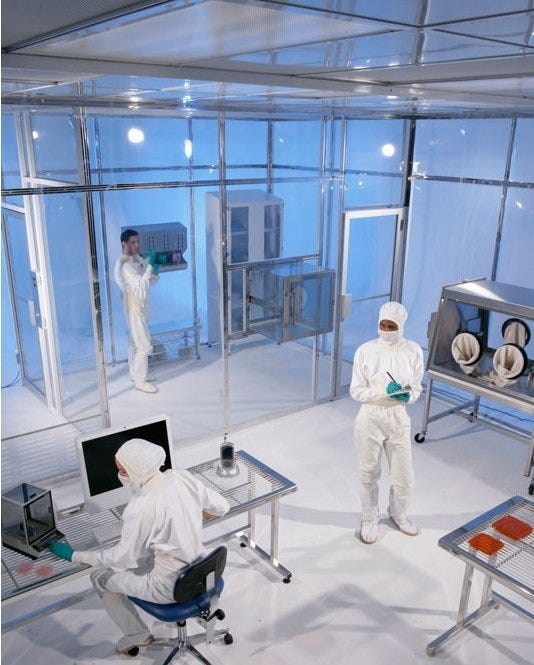Increasing energy costs don’t have to deplete your budget. Having an appropriate cleanroom design and selecting practical equipment can control energy-related expenses. Below are seven cost-efficient tactics to help you maintain your cleanroom performance and productivity without breaking your budget.
1) How big should your cleanroom be?
Let’s start with the decision of modular versus bricks-and-mortar. With a modular room, building permits are usually not required, and if your business moves to a different location, modular rooms can be disassembled and re-built in the new space.You should also consider the size of your cleanroom. Design the floor plan and height of the ceiling to meet your specific needs. Keep in mind the future you visualize for your controlled environment. Initially larger spaces are more expensive to construct and maintain, but if your facility plans on future expansion, a bigger cleanroom means you’re ready for operation when workflow increases: no waiting for additional components to arrive and be installed. 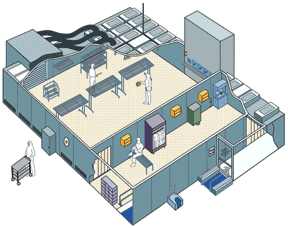
2) Do you have the right air conditioner?
Having the wrong air conditioning unit not only jeopardizes the integrity of your controlled space, but it also creates unnecessary costs.
Depending on the application, room and equipment size/type, and the quantity of personnel, your pre-existing HVAC (high-volume air conditioning) system might be the most economical option for cooling down your cleanroom. However, the cleanroom will impose additional thermal demands on the HVAC system, so you must ensure that it can handle the total energy load. In addition, some critical applications may require a dedicated system to ensure cleanroom temperature uniformity if the central system goes down. 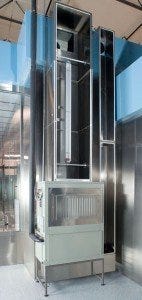
While a dedicated AC module offers a possible solution to an overworked HVAC unit, or to a building without an air conditioning system, it is not always the best answer. The AC module dumps heat generated by the compressor to the area surrounding your cleanroom. The result: an increased burden on your facility’s existing HVAC and the AC module as each system must work harder to lower the temperature of the ambient air. In order to operate in the most efficient manner, ventilation fans and exhaust ducts should be installed to redirect and release air outdoors—both of which cost money.
For larger modular cleanrooms, a split auxiliary central air system may be the best option. The heat-generating compressor is moved outside of the facility, decreasing the internal heat production. A recirculation system and ducting controls and routes an ample amount of exhaust air to the AC system before reaching the fan/filter units (FFUs), ensuring that heated air is not released into the surrounding facility.
3) How can a pass-through chamber save money?
A strategically placed pass-through or talk-through saves time and money. Fewer personnel are required to gown in order to transfer materials or supplies. The gowning process requires supplies, and can be time-consuming.
Although access doors are an effective way for employees to enter or exit a critical space, they present opportunities for pressure differential fluctuations between zones. The relatively small air volume of a pass-through chamber eliminates this issue, efficiently maintaining stable pressure and reducing contamination from added foot-traffic. Energy costs are contained by reducing pressure recovery times.
4) What type of fan/filter unit makes sense?
A number of costs are associated with replacing an FFU filter, including cleaning, testing, certifying, and restoring your controlled environment to the correct ISO level. Every hour of downtime equals lost revenue. With room-side replaceable (RSR) fan/filter units, contamination is prevented as the filter can be changed inside of the cleanroom without violating the ceiling barrier. The RSR eliminates the need for prolonged shutdowns during filter replacement.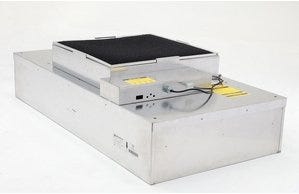
The European Union’s ErP 2015 Directive and California’s Title 24 have set a higher standard for low-energy use and associated energy-costs. To address this, particularly in facilities subject to low energy-use regulations, electrically-commutated (EC) fan/filter units with efficient DC motors are often required. Although these units typically have a higher purchase price, they quickly pay for themselves in terms of lower energy usage and power bills.
5) Would using a pre-filter help?
Absolutely! Pre-filters are less expensive than HEPA or ULPA filters and can be cleaned and reused. Certain pre-filters have been rated up to 80% efficient at removing linty dusts from airflow, decreasing the particle impact on your more FFU filter. Fewer particles mean a longer lasting HEPA and/or ULPA filter.
6) What is an economical lighting option?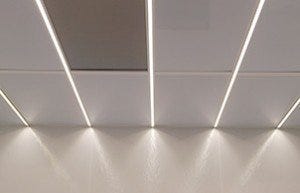
Energy-efficient LED (light-emitting diode) panels produce less heat, reducing cooling costs. The lumen output is similar to fluorescent lights, yet the bulbs last 5 to 8 times longer. For rooms with total or near-total FFU coverage, LED strips are adhered directly onto the ceiling grid between FFUs, ensuring laminar flow is not obstructed.
7) How is an EnergySaver system beneficial?
EnergySaver FFU control systems are paired with a power distribution module (PDM) to provide an easy approach for adjusting fan speeds. Climbing on a ladder to adjust individual FFU speed is no longer necessary! The EnergySaver eliminates ceiling breaches, allowing per-zone remote fine-tuning of flow volume, air change rate, and internal pressure. Night setback mode preserves the integrity of your cleanroom at a lower fan speed when the room is unoccupied—less heat is emitted and energy is saved.
To save, you first must invest; while some of these advanced features may initially cost more money, their energy-efficiency and low-maintenance requirements save substantially on a long-term basis.



